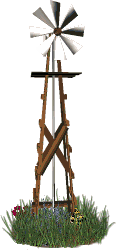"When you drink the water, remember the spring."- Chinese Proverb
Second only to breathable air, water is the most important need of mankind. Yet, a United Nations report warns that more than half of humanity will be living with water shortages, depleted fisheries and polluted coastlines within 50 years because of a worldwide water crisis. This report produced by more than 200 water resource experts working worldwide with the United Nations Environment Program further said that waste and inadequate management of water are the main culprits behind growing problems, particularly in poverty-ridden regions. Again economics lie behind a major problem facing mankind.
It becomes more and more important for everyone to learn how to obtain, use and conserve water. Part of a sustainable lifestyle involves water management. The FOOD section discusses some gardening methods that use water efficiently to grow produce. The SHELTER section shows methods of water conservation that can be implimented into house design.
Water Collection Methods - Wells & Pumps
The most common form of water collection is using a well and pump to extract ground water from the earth. These systems are typically electric but a growing number of sustainable homesteads are now utilizing modern wind powered pumps. These efficient "wind mills" use air pressure to lift water from as deep as 100 M (300 feet). The air lifts water by a combination of submerging the pump to a predetermined depth and injecting air into the pump casing, mixing with water, creating hydrostatic pressure and forcing the water-air mixture up. www.airifttech.com
AC and DC electric pumps powered by photo voltaic solar cells or wind powered generators can also be used. These can be set up to run off the homesteads electrical system or stand alone. Electric pumps typically use a significant amount of electrical energy and this should be considered when designing the system. I have even heard of a homestead that has a bicycle style human powered pump that is used to supplement their daily water needs as well as get a workout.
Rainwater Collection
One of the most often overlooked systems for the homestead is that of rainwater collection. Why pump up all your water needs from deep below the earth when you can collect rainwater for free. Even the dry areas of the southwest are finding the heavens provide substantial ammounts of rainfall to suppliment their water demands. In other areas rainwater collection has become the primary source of homestead hydration. You can calculate how many gallons a year you could collect from your homestead with the following formula.
House size (sq. ft.) x Rainfall (in.) x Efficiancy (%) x .623 gal/sq.ft.
For example if your house has a "footprint" of 1200 sqare feet (the roof pitch does not matter) and recieves some 30 inches of rain annually you can multiply these numbers by the efficiancy of your collection system. We will use a typical 75% for this illustration. Then multiply this figure by .623 gallons which is one inch of rain on one square foot of area.
1200 x 30 x .75 x .623 = 16821 gallons annually
If the average person uses 100 gallons a day this amount would account for nearly half their annual water needs. Of course heavier rainfalls and/or larger, efficiant collection systems would have more and waste less. Also, practicing conservation by reducing your water demands would make every drop go farther.
A simple rainwater collection system consists of a gutter system on your roof with downspouts that flow into storage tanks. The rainwater can then be filtered and used for most household needs. Some homesteads use well water for cooking and drinking and rainwater for everything else.
Conservation and Reclaimation
The use of low water capacity toilets, flow restrictors at shower heads and faucet aerators are fairly common now. Water to the toilet can be even be eliminated with the use of modern composting toilet systems. High tech washing machines require a fraction of the water old models did. Instead of wasting grey water it can be diverted from bathing, clothes washing and bathroom sinks to watering plants. Using modern gardening technics radically reduce hydration needs. Also, landscaping with drought tolerant, indigenous plants can save an enormous amount of water.
We believe in taking care of our part of God's creation from the air and soil,
to the water, to the vegetation, to the animals and the wildlife that live here.

